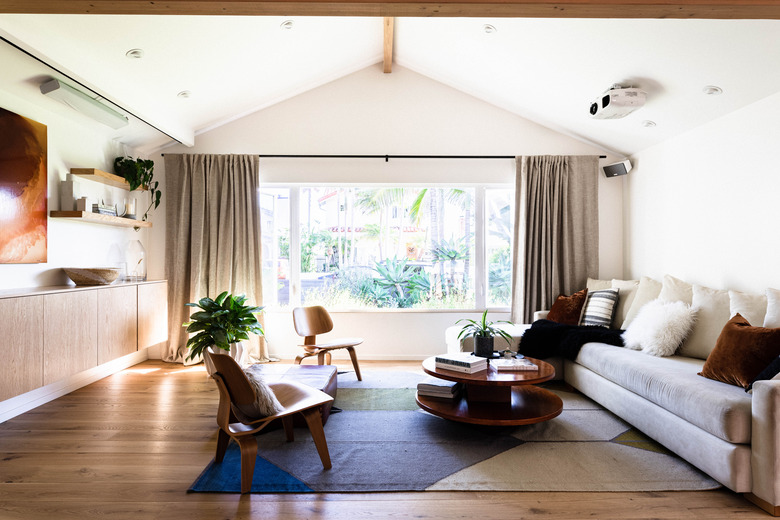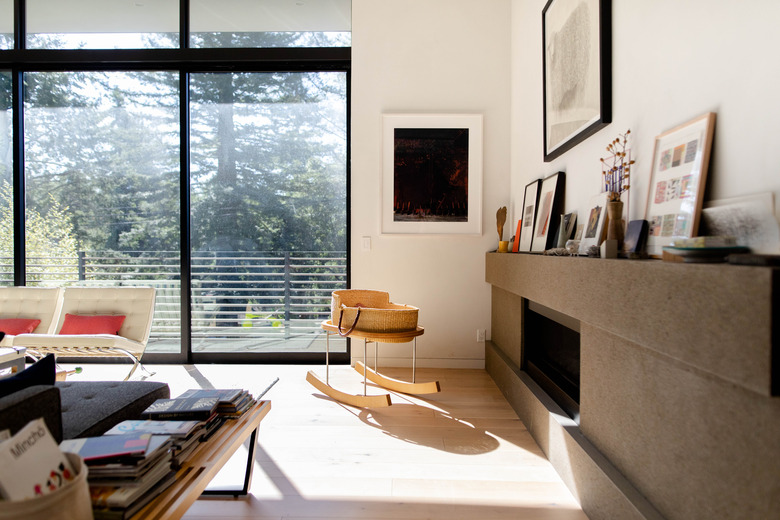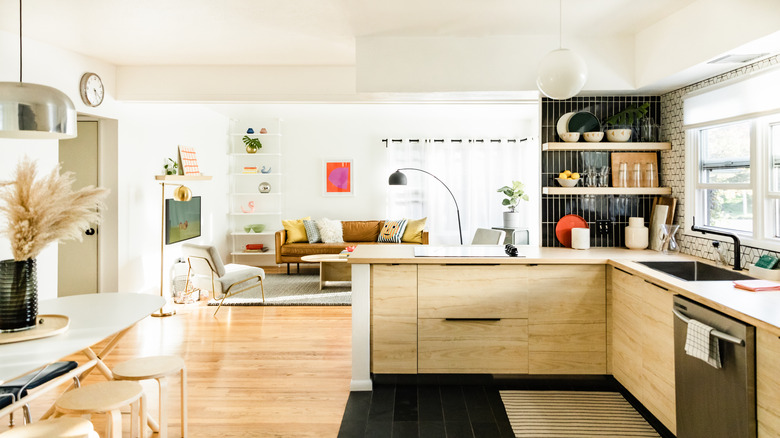Engineered Bamboo Flooring: What You Need To Know
As bamboo flooring has become a popular alternative to hardwood, many people wonder how engineered bamboo flooring may compare to solid bamboo or engineered hardwood. While engineered bamboo shares many similarities with other flooring options, it also has its own unique characteristics that make it stand out as the best choice for many homeowners.
How Bamboo Flooring Is Made
How Bamboo Flooring Is Made
Both solid and engineered bamboo flooring are made from a select number of bamboo species, which are highly sustainable and reach their full height of between 40 to 80 feet within one year and grow to a total width of up to 6 to 8 inches within five years. Bamboo stalks can be harvested from the main plant once every three years without damaging the plant itself or the surrounding grove. Once harvested, bamboo is then dried and cut into strips between 1/4- and 3/4-inch wide. The strips are arranged in one of three ways to create flooring.
- Horizontal: In this manufacturing method, strips are glued
edge-to-edge with the skin side facing up, showing as much of the stalk as
possible. This method looks the most like what people envision bamboo flooring
to look like because it shows the bamboo nodes (also called knuckles). These
can be sold in natural shades, or they can be stained or be carbonized, meaning the bamboo
is heat treated during manufacturing to give it a rich, caramel color. - Vertical: To make these boards, bamboo strips are glued so
the narrow edges face upward, creating a floor that is harder than horizontal
bamboo and shows fewer knuckles. While these planks can be carbonized, they are
not usually stained because they cannot absorb stain easily. - Strand woven: The newest form of bamboo flooring, these
planks are manufactured by soaking the strips in an adhesive and then laying them
out lengthwise in a variety of orientations before they are compressed together
in a hydraulic press and then milled into floorboards. This material is two to
three times more dense than planks created through other bamboo-manufacturing methods.
Plus, the final appearance can also be modified through a wide variety of
special finishes and surface treatments (it can be wire brushed or hand scraped,
for example) that might not work on horizontal and vertical bamboo flooring.
Technically, experts like those at North Carolina State University consider all forms of bamboo flooring to be engineered, since they are manufactured rather than cut from a solid piece of hardwood — but when people talk about "engineered bamboo flooring," they are talking about material with a construction similar to engineered hardwood flooring. This means that a thin layer of hardwood is glued on top of an inexpensive wood backing material, such as plywood or high-density fiberboard (HDF). In the case of bamboo, a thin layer of the composite bamboo material (whether horizontal, vertical or strand-woven bamboo) is then attached to the plywood or HDF.
Engineered vs. Solid Bamboo Flooring
Engineered vs. Solid Bamboo Flooring
After bamboo flooring has been laid, it is impossible to tell if it is solid or engineered. The two materials look and feel exactly the same. Most manufacturers even offer the same warranty for both their engineered and solid bamboo floors, offering 50 or more years of coverage on the structure of the bamboo material and a guarantee of 15 or more years on the factory finish.
That being said, one big difference between engineered and solid bamboo floors is the number of times a floor can be sanded and refinished. While the specific number will vary from manufacturer to manufacturer based on the thickness of the bamboo, solid bamboo flooring can generally be refinished at least a few times more than engineered bamboo.
Because solid bamboo flooring features more bamboo, which is more expensive than HDF or other inexpensive materials used in engineered flooring boards, solid bamboo flooring is usually more expensive than engineered flooring. In fact, while most solid bamboo flooring goes for $3 to $6 per square foot, engineered bamboo flooring is around $2 to $4 per square foot.
Most solid bamboo flooring is sold in plank widths of 3 3/4-inches wide, while engineered bamboo comes in a variety of sizes all the way up to 9 inches. When purchasing wide planks, expect to pay far more, even with engineered flooring. It's also worth noting that while some companies offer unfinished solid bamboo flooring, it is impossible to find engineered bamboo flooring that is not prefinished.
Solid bamboo floors tend to be more susceptible to shrinkage and warping due to humidity than engineered flooring. One unique property of solid bamboo flooring is that when cut properly, it can be installed through a floating click-and-lock technique, so each board is connected to the one before it but not secured to the floor itself. Solid hardwood cannot be installed this way.
It is worth noting that these floating floors are prone to warping and should only be installed in areas with few fluctuations in humidity. Similarly, while floating solid bamboo floors can be installed directly on a concrete subfloor, these should not be used in basements or other below-grade rooms without a sufficiently waterproof underlayment, as concrete floors in these rooms can have excessive moisture.
Engineered Bamboo vs. Engineered Hardwood Flooring
Engineered Bamboo vs. Engineered Hardwood
Flooring
Engineered hardwood is just like engineered bamboo in that it only features a slim layer of the advertised material glued to a less-expensive wood core. People often purchase engineered hardwood flooring because compared to traditional solid hardwood flooring, it tends to be less expensive. Also, since most solid hardwoods contract and shrink with drastic changes in temperature, they cannot be used for flooring over radiant heat sources, whereas engineered flooring can adapt to these temperature changes just fine. However, all forms of bamboo offer these same benefits.
Another downside of hardwood flooring is that it almost always has to be nailed down, and some hardwoods are very dense, making them particularly hard to nail down. On the other hand, engineered flooring can be installed with a click-and-lock method or can be nailed down. When nailed down, the material is generally softer to nail as well. Solid bamboo can be difficult to nail down, but engineered bamboo has the same base material as engineered hardwood and is similarly easy to nail down.
One of the big selling points of bamboo over hardwood in general is still true when it comes to engineered flooring: bamboo is more sustainable because it grows so quickly and abundantly. In fact, bamboo grows as fast as 15 times the speed of most trees, and shoots from the main plant can be harvested without damaging the plant itself.
Bamboo is also cheaper than many hardwoods. Whereas engineered bamboo goes for $2 to $4 per square foot, engineered hardwood is usually around $3 to $5 per square foot. In fact, because strand-woven bamboo can be produced to resemble traditional woods such as maple and walnut or more exotic wood species like tigerwood, it can often be preferable to choose engineered bamboo over these engineered hardwoods for both sustainability and affordability reasons.
Understanding Bamboo Hardness
Understanding Bamboo Hardness
It's worth mentioning that while some manufacturers promote their engineered bamboo flooring by advertising the fact that bamboo is substantially harder than many other hardwoods, this information is mostly a marketing tactic and is not a good way to evaluate engineered bamboo flooring. It is true that on the Janka hardness scale, which measures the hardness of a wood, strand-woven bamboo is rated at 3,270, whereas red oak is rated at 1,260, and even the notably hard Brazilian cherry is only rated at 2,820.
However, there is a lot of variation in the hardness of bamboo flooring. For example, when bamboo is carbonized to give it a deeper coloration, it actually becomes up to 30 percent softer — in fact, carbonized horizontal bamboo is rated at only 1,180. On the other hand, the manufacturer Cali Bamboo developed its own trademarked manufacturing technique for making the hardest bamboo flooring on the market, which it calls "fossilized" bamboo. It is rated at an amazing 5,574.
More importantly, what these companies don't mention when talking about engineered bamboo flooring is that the Janka hardness scale doesn't actually apply to engineered wood. That's because while the floors may feature a layer of bamboo or hardwood, the base of the boards is still made with a softer wood. While it's logical to assume that an engineered wood board with a harder material on the top would be more dent-resistant than one with a softer material, it's impossible to fairly compare engineered flooring hardness because different manufacturers use top layers of varying thicknesses and different base materials.
As an example, one company may sell engineered bamboo flooring with a nearly paper-thin layer of bamboo glued to HDF, while another sells red oak 1/2-inch thick that goes down to the tongue and groove of the board where it is backed by plywood. Just because bamboo is nearly two-and-a-half times as hard as red oak doesn't mean the engineered floor board will reflect this fact.
One upshot to this fact is that when deciding between fossilized bamboo and carbonized bamboo, you can focus just on the appearance, quality and price of the engineered planks rather than worrying about their relative hardness.
Whatever material you're considering, be sure to compare the thickness of the engineered flooring's top layer, which generally is between 0.6 to 4 millimeters. This is not simply a measure of the quality of the board: a thicker wear layer ensures your floor can be refinished at least a few times.
Benefits and Drawbacks of Engineered Bamboo Flooring
Benefits and Drawbacks of Engineered Bamboo Flooring
When choosing between engineered bamboo flooring and other flooring options, there are many reasons to choose bamboo. These include:
- Affordability:
Engineered bamboo flooring is cheaper than the great majority of engineered
hardwoods and solid bamboo flooring. - Sustainability: Bamboo
is one of the fastest-growing plants on earth and can even be harvested without
damaging the plant or the surrounding grove. - Easy to install:
While all engineered hardwoods and solid bamboo flooring share this benefit,
it's worth mentioning that installing engineered bamboo is a fairly simple DIY
process. That's the case whether you choose a nail-down or floating installation
method. - Easy to clean: A
broom, dustpan, mop and hardwood floor cleaner are all you need to keep an
engineered bamboo floor clean. For spills, use a sponge and dry cloth to wipe
up liquids immediately. - Radiant heat compatible: While it isn't always easy to install certain hardwoods over
radiant floor heating, engineered bamboo flooring is almost universally
compatible with this option.
Naturally, every floor covering has its disadvantages as well. Some of the main drawbacks of engineered bamboo include:
- Quality issues:
Bamboo that was harvested during the wrong time of year or improperly manufactured
can crack or shrink. To avoid these problems, check the label to make sure your
flooring material was properly inspected and collected, and only buy bamboo
flooring with a lengthy structural warranty. - Easy to scratch:
While bamboo is particularly hard, it is not any more scratch-resistant than hardwood, and some manufacturers of particularly low-cost bamboo have been known to use inferior finishes that scratch easily. Minor
scratches can be fixed temporarily with a refinishing pen or crayon, but
eventually, you'll need to refinish the floor, and engineered bamboo cannot be
refinished as many times as solid bamboo. For best results, buy boards with the
thickest-possible wear layer and a long warranty on the finish. - Chemicals: All bamboo flooring is glued together, and some less-reputable
manufacturers use cheap glues filled with volatile organic chemicals and
formaldehyde, which are known carcinogens and can cause breathing problems.
Only buy floors that have been certified by independent parties such as
FloorScor or Greenguard, which guarantees they will not emit dangerous levels of toxic chemicals into your home.
References
- Ambient Bamboo Floors: 5 Different Types of Bamboo Flooring – Pros & Cons
- NC State University: Nomenclature for Engineered Bamboo
- BuildDirect: What is the Janka Hardness Scale?
- Wisteria Lane: Carbonized Bamboo
- Floor Critics: Bamboo Flooring: Reviews, Best Brands & Pros vs. Cons
- Cali Bamboo: What Makes Fossilized Flooring So Hard?
- BuildDirect: Bamboo Flooring vs Engineered Hardwood: What You Need to Know
- Ambient Bamboo Floors: Guide To The Different Types Of Solid Bamboo Flooring


